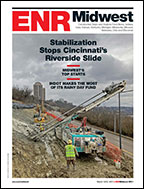Related Links:
Crews are driving soil nails into an East Tennessee hillside to stabilize land around a section of Interstate 75 after a massive slide took out southbound lanes, which could be closed all summer.
Elmo Greer & Sons LLC, East Bernstadt, Ky., already had crews on-site when the slide occurred on May 8. The contractor was repairing damage to the highway after a section of embankment collapsed on March 8.
Greer’s $9.3-million contract, awarded in April, calls for removing a section of highway, going to bedrock, and stabilizing and rebuilding the slope.
The latest slide, on a 180-ft embankment, has added to the work, but neither the contract nor the Sept. 28 deadline has changed, Mark Nagi, Tennessee Dept. of Transportation (TDOT) spokesman, said.
Before the highway can be rebuilt, “there will have to be temporary excavation that will leave that side of the interstate unprotected and almost vertical,” Saieb Haddad, TDOT geotechnical engineer, said.
“We are assessing the situation day by day,” he said.
Current plans call for using specialized launch nails—20-ft pieces of rebar shot straight into the hillside—for stabilization, in addition to the rebar-and-grout combination of soil nails, he said.
Depending on subsurface investigation, crews may also use 10-ft to 15-ft post-tension nails to strengthen and stabilize the area.
Further, subcontractor Soil Nail Launcher Inc., Grand Junction, Colo., is putting 20-ft and 50-ft nails under the northbound lanes, Nagi said.
After placing more than 200 soil nails, crews will cover the area with fencing and grout for additional stabilization before bringing in more than 200,000 tons of rock to build the new embankment, Haddad said.
TDOT currently has single north- and southbound lanes open on I-75, which has an average traffic load of 28,340 vehicles daily. The agency has posted alternate routes for both traffic in both directions, routing it through Caryville, LaFollette and Jellico. Wide loads must take other highways.
Plans now call for having two northbound and one southbound lane open by the end of May.
“But we are evaluating it every day,” Haddad added.
The slide is at mile marker 143, and the crossover runs between mile marker 144 and mile marker 141.
A previous slide hit the area—about a mile south of the current slide—in 2005, Nagi said.
“The 2012 landslide is much larger in scale,” Nagi added.
There is no single reason for the latest slide, Haddad said.
Instead, the landslide was caused by a combination of factors: a slope built 50 years ago, recent heavy rainfalls and the use of native materials, such as shale, from the cut in the mountain to build the embankment when the highway was under construction.
Shale retains its strength as long as it is dry but loses strength when exposed to moisture. “[It] makes the embankment a lot weaker that it is supposed to be,” Haddad said.
There are also streams on the other side of the highway that feed into the bottom of the embankment, further weakening it.
Today, design and construction requirements would not allow a top-to-bottom flat slope to prevent runoff from eroding the face of the slope, Haddad said.
“Now, we would design it with benches and divide that area every 30 ft to 35 ft with a bench [to stop runoff]," Haddad said






